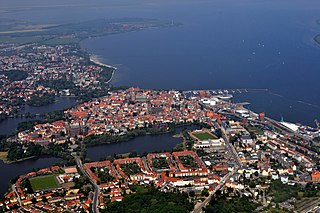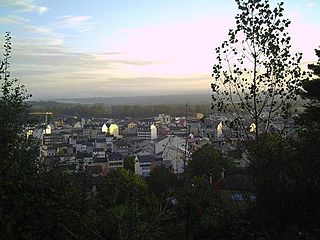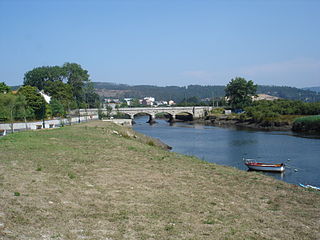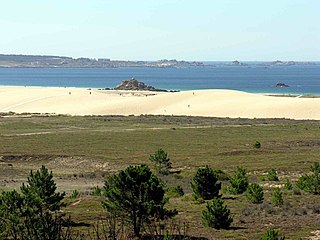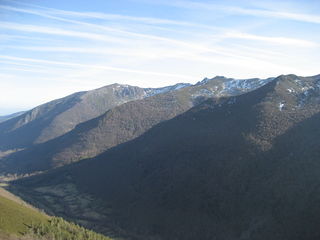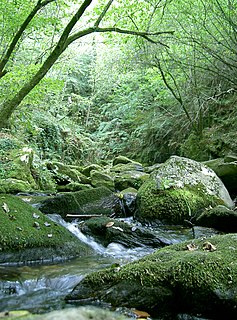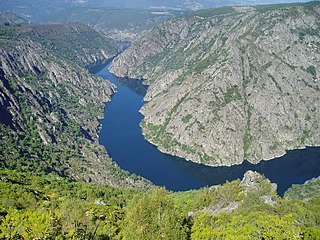This is a list of Sites of Community Importance in Galicia .
| ID | Name | Coordinates | Image |
|---|---|---|---|
| ES0000001 | Cíes Islands (official name: Illas Cíes) Other names: n/a | 42°13′00″N8°54′16″W / 42.2167°N 8.9044°W |  |
| ES1110001 | Ortigueira - Mera (official name: Ortigueira - Mera) Other names: n/a | 43°42′11″N7°50′07″W / 43.7031°N 7.8352°W |  |
| ES1110002 | Costa Ártabra (official name: Costa Ártabra) Other names: n/a | 43°43′05″N7°57′17″W / 43.7181°N 7.9548°W |  |
| ES1110003 | Fragas do Eume (official name: Fragas do Eume) Other names: n/a | 43°22′52″N7°59′36″W / 43.3812°N 7.9934°W |  |
| ES1110004 | Encoro de Abegondo - Cecebre (official name: Encoro de Abegondo - Cecebre) Other names: n/a | 43°16′17″N8°15′46″W / 43.2715°N 8.2628°W |  |
| ES1110005 | Costa da Morte (official name: Costa da Morte) Other names: n/a | 42°52′06″N9°14′41″W / 42.8683°N 9.2448°W |  |
| ES1110006 | The Dunes of Corrubedo Natural Park (official name: Complexo húmido de Corrubedo) Other names: n/a | 42°31′50″N9°05′25″W / 42.5306°N 9.0903°W |  |
| ES1110007 | Betanzos - Mandeo (official name: Betanzos - Mandeo) Other names: n/a | 43°15′07″N8°07′02″W / 43.2519°N 8.1173°W |  |
| ES1110008 | Carnota - Monte Pindo (official name: Carnota - Monte Pindo) Other names: n/a | 42°53′25″N9°07′08″W / 42.8902°N 9.1189°W |  |
| ES1110009 | Costa de Dexo (official name: Costa de Dexo) Other names: n/a | 43°23′57″N8°19′39″W / 43.3991°N 8.3275°W |  |
| ES1110010 | Punta de Estaca de Bares (official name: Estaca de Bares) Other names: n/a | 43°46′06″N7°41′48″W / 43.7683°N 7.6967°W |  |
| ES1110011 | Esteiro do Tambre (official name: Esteiro do Tambre) Other names: n/a | 42°48′28″N8°54′07″W / 42.8078°N 8.9019°W |  |
| ES1110012 | Monte e lagoa de Louro (official name: Monte e lagoa de Louro) Other names: n/a | 42°45′39″N9°06′54″W / 42.7609°N 9.1149°W | |
| ES1110013 | Xubia - Castro (official name: Xubia - Castro) Other names: n/a | 43°28′47″N8°01′27″W / 43.4797°N 8.0241°W |  |
| ES1110014 | Serra do Careón (official name: Serra do Careón) Other names: n/a | 42°55′17″N7°57′20″W / 42.9214°N 7.9556°W |  |
| ES1110015 | Anllóns (official name: Río Anllóns) Other names: n/a | 43°13′55″N8°50′14″W / 43.2319°N 8.8371°W |  |
| ES1110016 | Tambre (river) (official name: Río Tambre) Other names: n/a | 42°57′47″N8°26′24″W / 42.963°N 8.4401°W |  |
| ES1120001 | Ancares - Courel (official name: Ancares - Courel) Other names: n/a | 42°52′33″N6°57′57″W / 42.8758°N 6.9657°W |  |
| ES1120002 | Eo (river) (official name: Río Eo) Other names: n/a | 43°31′15″N7°02′44″W / 43.5208°N 7.0455°W |  |
| ES1120003 | Parga - Ladra - Támoga (official name: Parga - Ladra - Támoga) Other names: n/a | 43°09′53″N7°34′08″W / 43.1648°N 7.5689°W |  |
| ES1120004 | A Marronda (official name: A Marronda) Other names: n/a | 43°06′09″N7°12′57″W / 43.1024°N 7.2157°W |  |
| ES1120005 | As Catedrais beach (official name: As Catedrais) Other names: n/a | 43°33′11″N7°07′21″W / 43.5531°N 7.1226°W |  |
| ES1120006 | Carballido (official name: Carballido) Other names: n/a | 43°17′08″N7°09′08″W / 43.2856°N 7.1523°W |  |
| ES1120007 | Cruzul - Agüeira (official name: Cruzul - Agüeira) Other names: n/a | 42°50′48″N7°09′15″W / 42.8467°N 7.1542°W |  |
| ES1120008 | Monte Faro (official name: Monte Faro) Other names: n/a | 42°37′44″N7°53′26″W / 42.6288°N 7.8906°W |  |
| ES1120009 | Monte Maior (official name: Monte Maior) Other names: n/a | 43°38′29″N7°32′11″W / 43.6415°N 7.5364°W |  |
| ES1120010 | Negueira (official name: Negueira) Other names: n/a | 43°08′08″N6°52′09″W / 43.1355°N 6.8693°W |  |
| ES1120011 | Ría de Foz - Masma (official name: Ría de Foz - Masma) Other names: n/a | 43°32′54″N7°15′37″W / 43.5483°N 7.2604°W |  |
| ES1120012 | Río Landro (official name: Río Landro) Other names: n/a | 43°37′43″N7°37′03″W / 43.6287°N 7.6175°W |  |
| ES1120013 | Río Ouro (official name: Río Ouro) Other names: n/a | 43°31′54″N7°25′18″W / 43.5318°N 7.4217°W |  |
| ES1120014 | Sil Canyon (official name: Canón do Sil) Other names: n/a | 42°25′11″N7°37′45″W / 42.4198°N 7.6292°W |  |
| ES1120015 | Serra do Xistral (official name: Serra do Xistral) Other names: n/a | 43°27′23″N7°34′36″W / 43.4564°N 7.5767°W |  |
| ES1120016 | Río Cabe (official name: Río Cabe) Other names: n/a | 42°38′39″N7°24′02″W / 42.6441°N 7.4006°W |  |
| ES1120017 | Costa da Mariña occidental (official name: Costa da Mariña occidental) Other names: n/a | 43°43′25″N7°37′47″W / 43.7237°N 7.6297°W |  |
| ES1130001 | Baixa Limia – Serra do Xurés (official name: Baixa Limia) Other names: n/a | 41°54′01″N7°59′08″W / 41.9004°N 7.9855°W |  |
| ES1130002 | Macizo Central (official name: Macizo Central) Other names: n/a | 42°13′03″N7°17′09″W / 42.2175°N 7.2858°W |  |
| ES1130003 | Bidueiral de Montederramo (official name: Bidueiral de Montederramo) Other names: n/a | 42°13′22″N7°29′28″W / 42.2229°N 7.4912°W |  |
| ES1130004 | Pena Veidosa (official name: Pena Veidosa) Other names: n/a | 42°31′43″N7°55′49″W / 42.5286°N 7.9303°W |  |
| ES1130005 | Tâmega (river) (official name: Río Támega) Other names: n/a | 41°55′25″N7°24′54″W / 41.9235°N 7.4149°W |  |
| ES1130006 | Veiga de Ponteliñares (official name: Veiga de Ponteliñares) Other names: n/a | 42°02′32″N7°51′01″W / 42.0423°N 7.8504°W |  |
| ES1130007 | Trevinca (official name: Pena Trevinca) Other names: n/a | 42°15′03″N6°51′25″W / 42.2507°N 6.857°W |  |
| ES1130008 | Pena Maseira (official name: Pena Maseira) Other names: n/a | 41°59′00″N7°00′48″W / 41.9833°N 7.0134°W |  |
| ES1130009 | Serra da Enciña da Lastra (official name: Serra da Enciña da Lastra) Other names: n/a | 42°28′38″N6°50′20″W / 42.4773°N 6.8389°W |  |
| ES1140001 | Sistema fluvial Ulla - Deza (official name: Sistema fluvial Ulla - Deza) Other names: n/a | 42°45′25″N8°29′45″W / 42.7569°N 8.4957°W |  |
| ES1140002 | Lérez (official name: Río Lérez) Other names: n/a | 42°27′07″N8°36′14″W / 42.4519°N 8.604°W |  |
| ES1140003 | A Ramallosa (official name: A Ramallosa) Other names: n/a | 42°07′04″N8°49′09″W / 42.1177°N 8.8191°W |  |
| ES1140004 | Atlantic Islands of Galicia National Park (official name: Complexo Ons - O Grove) Other names: n/a | 42°22′55″N8°54′36″W / 42.382°N 8.9099°W |  |
| ES1140005 | Monte Aloia (official name: Monte Aloia) Other names: n/a | 42°04′56″N8°40′48″W / 42.0822°N 8.68°W |  |
| ES1140006 | Río Tea (official name: Río Tea) Other names: n/a | 42°12′43″N8°26′14″W / 42.212°N 8.4373°W |  |
| ES1140007 | O Baixo Miño (official name: Baixo Miño) Other names: n/a | 42°58′58″N8°42′35″W / 42.9829°N 8.7096°W |  |
| ES1140008 | Brañas de Xestoso (official name: Brañas de Xestoso) Other names: n/a | 42°40′42″N8°19′43″W / 42.6784°N 8.3286°W |  |
| ES1140009 | Cabo Udra (official name: Cabo Udra) Other names: n/a | 42°19′26″N8°49′42″W / 42.324°N 8.8284°W |  |
| ES1140010 | Costa da Vela (official name: Costa da Vela) Other names: n/a | 42°16′38″N8°52′05″W / 42.2773°N 8.868°W |  |
| ES1140011 | Gándaras de Budiño (official name: Gándaras de Budiño) Other names: n/a | 42°03′44″N8°37′45″W / 42.0622°N 8.6291°W |  |
| ES1140012 | Illas Estelas (official name: Illas Estelas) Other names: n/a | 42°09′00″N8°51′35″W / 42.15°N 8.8597°W |  |
| ES1140013 | Serra do Candán (official name: Serra do Candán) Other names: n/a | 42°34′17″N8°14′35″W / 42.5715°N 8.243°W |  |
| ES1140014 | Serra do Cando (official name: Serra do Cando) Other names: n/a | 42°27′58″N8°23′19″W / 42.466°N 8.3887°W |  |
| ES1140015 | Sobreirais do Arnego (official name: Sobreirais do Arnego) Other names: n/a | 42°46′04″N8°05′21″W / 42.7677°N 8.0893°W |  |
| ES1140016 | Enseada de San Simón (official name: Enseada de San Simón) Other names: n/a | 42°18′44″N8°38′18″W / 42.3121°N 8.6383°W |  |



